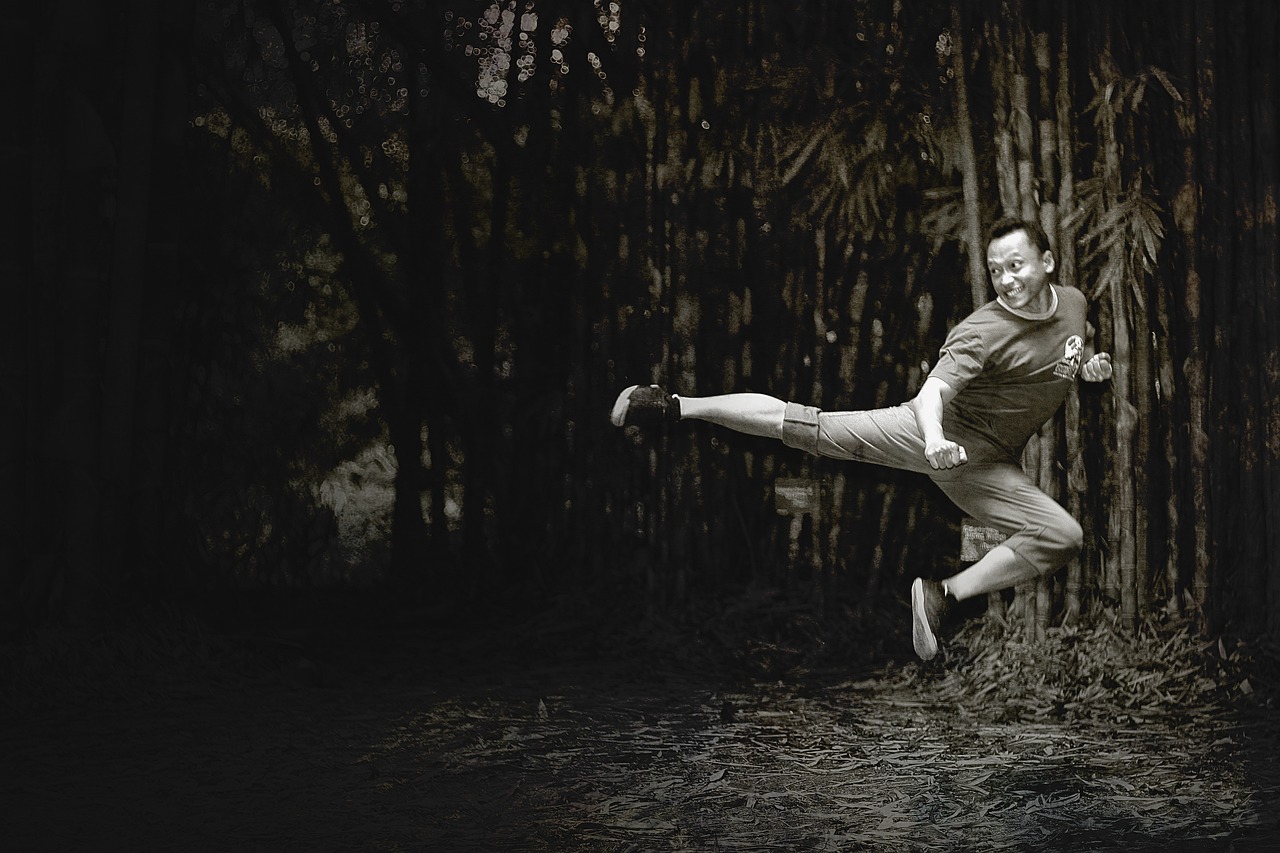Three Essential Kick Techniques in Self-Defense Training
In today's world, personal safety has become a significant concern for many people. Whether you're walking home late at night or simply want to feel more secure in your daily life, knowing some self-defense techniques can be incredibly empowering. Among the various techniques available, mastering a few essential kicks can make a world of difference. This article explores three fundamental kick techniques that are crucial for self-defense training, providing insights into their execution, benefits, and applications in real-life situations. By the end, you'll not only understand these techniques but also feel more confident in your ability to protect yourself.
The front kick is a powerful technique that targets an opponent's midsection, delivering a strong blow that can create the necessary space for you to escape. To execute a front kick effectively, you need to lift your knee high and extend your foot forward, striking with the ball of your foot. This motion not only requires strength but also flexibility and precision. The front kick is particularly advantageous because it keeps your opponent at bay, allowing you to maintain distance and control the situation. Imagine it as a way to push away an unwanted guest at a party; it’s all about creating space and asserting your boundaries.
The roundhouse kick is a versatile technique that can be used to strike an opponent from various angles, making it a favorite among martial artists. This kick involves a pivot on your standing foot, followed by a sweeping motion of your kicking leg aimed at the opponent’s head or torso. The beauty of the roundhouse kick lies in its adaptability; it can be executed quickly and with great force, allowing you to respond effectively to different threats. Think of it like a baseball bat swinging through the air, targeting the ball—your opponent is the ball, and you want to hit it with precision.
Understanding the mechanics of the roundhouse kick is essential for effectiveness. Start in a proper stance, with your feet shoulder-width apart. As you prepare to kick, pivot on your standing foot, turning your hips and shoulders toward the target. Your kicking leg should come up and around in a circular motion, striking with the instep or shin. Remember, follow-through is crucial; you want to ensure that your kick doesn’t just stop at impact but continues through to maintain balance and power.
Identifying and avoiding common mistakes when executing the roundhouse kick can significantly improve your performance. Here are a few frequent errors to watch out for:
- Insufficient Pivot: Failing to pivot properly can lead to loss of balance and power.
- Weak Follow-Through: Stopping your kick too soon can make it less effective and leave you vulnerable.
- Incorrect Targeting: Striking the wrong part of the opponent can waste energy and open you up to counterattacks.
By focusing on these aspects, you can enhance your technique and effectiveness.
Practicing drills is crucial for mastering the roundhouse kick. Here are some specific drills you can incorporate into your training routine:
- Shadow Kicking: Practice your kicks in front of a mirror to check your form and technique.
- Target Kicking: Use a heavy bag or pads to practice your kicks, focusing on accuracy and power.
- Partner Drills: Work with a partner to practice timing and distance with controlled kicks.
These drills will help improve your accuracy, speed, and power, making your self-defense skills more effective.
The roundhouse kick can be effectively applied in various self-defense situations. For instance, if an attacker approaches from the side, a well-timed roundhouse kick can catch them off guard and create an opportunity for escape. It’s also useful in close quarters, where you can use the kick to push back an aggressor. The adaptability of this kick makes it a valuable tool in your self-defense arsenal.
The side kick is another powerful defensive maneuver that provides both distance and control. When executed correctly, this kick can push an opponent away, giving you the space you need to escape or prepare for another move. The side kick is particularly effective against an attacker who is charging at you, as it allows you to strike while maintaining a strong stance. Think of it as a door slamming shut on someone trying to force their way in; it’s a strong barrier that says, "not today."
Mastering the side kick requires attention to detail. Start by positioning your body correctly; your standing leg should be slightly bent, and your kicking leg should be brought up to the side. As you kick, extend your leg outwards, striking with the heel or the side of your foot. Focus on your target, ensuring that you aim for the midsection or knee of your opponent for maximum impact. This technique not only requires strength but also balance and coordination.
Incorporating the side kick into your defensive strategies can enhance your overall effectiveness. For example, if someone is trying to grab you, a quick side kick can create the necessary distance to deter them. Additionally, using the side kick in combination with other techniques can confuse your attacker, making it harder for them to predict your next move. The key is to remain calm and focused, using your kicks as a means of control rather than aggression.
Q: How long does it take to master these kicks?
A: Mastery varies by individual, but consistent practice over weeks or months can lead to significant improvement.
Q: Can I use these kicks in real-life situations?
A: Yes, these techniques are designed for self-defense and can be effective when executed properly.
Q: Do I need prior martial arts experience to learn these kicks?
A: No prior experience is necessary, but a willingness to learn and practice regularly will help you succeed.

The Front Kick
The front kick is often hailed as one of the most fundamental and effective techniques in self-defense training. It’s like the bread and butter of kicking techniques—simple yet powerful. When executed correctly, it can deliver a devastating blow to an opponent's midsection, creating just enough distance for you to escape or prepare for your next move. Imagine being able to stop an attacker in their tracks with a single, swift motion! In this section, we will dive deep into the mechanics of the front kick, its advantages, and how you can seamlessly incorporate it into your self-defense repertoire.
So, how does the front kick work? At its core, the front kick involves lifting your knee up and extending your foot forward, targeting your opponent's torso or face. The beauty of this technique lies in its directness. You can execute it from a standing position, making it accessible in various situations. To perform a front kick, follow these steps:
- Stance: Start in a fighting stance with your feet shoulder-width apart.
- Knee Lift: Raise your knee towards your chest, keeping your foot flexed.
- Extension: Extend your leg forward, striking with the ball of your foot.
- Recoil: Quickly bring your foot back to the starting position to maintain balance.
One of the significant advantages of the front kick is its ability to create space between you and your attacker. This is crucial in self-defense situations where distance can mean the difference between safety and harm. Additionally, the front kick is versatile; it can be aimed at different targets, from the abdomen to the face, depending on the situation. This adaptability makes it an essential tool in your self-defense arsenal.
Moreover, practicing the front kick regularly can enhance your overall fitness. It engages multiple muscle groups, improving your strength, balance, and coordination. Think of it as a workout disguised as self-defense training! You’re not just learning to protect yourself; you’re also getting fit in the process.
Incorporating the front kick into your self-defense training can significantly boost your confidence. The more you practice, the more natural it becomes, allowing you to react instinctively in high-pressure situations. It's like learning to ride a bike; once you get the hang of it, you can ride without thinking!
To help you visualize the effectiveness of the front kick, here’s a quick comparison table of its advantages:
| Advantage | Description |
|---|---|
| Distance Creation | Creates space between you and the attacker. |
| Versatility | Can target various areas of the body. |
| Fitness Benefits | Enhances strength, balance, and coordination. |
| Confidence Boost | Improves your ability to react in self-defense scenarios. |
In conclusion, mastering the front kick is not just about learning a technique; it’s about empowering yourself with the skills needed to protect and defend. As you practice, remember that every kick brings you one step closer to becoming more confident and capable in real-life situations. So lace up those training shoes, and let’s get kicking!

The Roundhouse Kick
The roundhouse kick is not just a flashy move you see in martial arts movies; it’s a highly effective technique that can be a game changer in self-defense situations. Imagine being able to strike an opponent with power and precision from various angles, leaving them stunned and giving you the upper hand. This kick is versatile, allowing you to target different areas of your opponent’s body, making it a crucial addition to your self-defense arsenal. Whether you’re facing an aggressor in a dark alley or just practicing in the dojo, mastering the roundhouse kick can significantly enhance your confidence and safety.
To effectively execute a roundhouse kick, you need to understand its mechanics. The movement starts with proper stance, where your feet should be shoulder-width apart, and your knees slightly bent. As you prepare to kick, pivot on the supporting foot while rotating your hips and shoulders. This motion generates the necessary power for the kick. The goal is to strike with the instep or shin, aiming for the opponent’s midsection or head. When done correctly, the roundhouse kick can deliver a powerful blow that can incapacitate an attacker.
One of the key advantages of the roundhouse kick is its adaptability. You can use it in various self-defense scenarios, whether you need to create distance from an approaching threat or deliver a quick strike to disable an attacker. Its versatility allows you to strike from different angles, making it difficult for your opponent to anticipate your moves. This unpredictability can be your greatest ally in a self-defense situation.
Understanding the mechanics of the roundhouse kick is essential for effectiveness. Start by positioning yourself in a guard stance, with your hands up and ready to protect your face. As you initiate the kick, pivot on your supporting foot, turning it outward to allow for a full rotation of your hips. Your kicking leg should extend outwards in a sweeping motion, aiming to connect with your target using the top of your foot or shin. It’s important to follow through with the kick, allowing your body to rotate back into the guard position to maintain balance and readiness for the next move.
Many beginners fall into the trap of making common mistakes that can undermine their technique. Here are a few pitfalls to watch out for:
- Insufficient Pivoting: Failing to pivot on the supporting foot can lead to a loss of power and balance.
- Overextending the Kick: Kicking too high or too far can leave you vulnerable to counterattacks.
- Neglecting the Follow-Through: Not following through can result in a weak kick and poor recovery.
By being aware of these mistakes and correcting them, you can enhance your roundhouse kick and boost your overall self-defense skills.
To truly master the roundhouse kick, consistent practice is key. Here are a few drills you can incorporate into your training routine:
- Shadow Kicking: Practice the roundhouse kick in front of a mirror to perfect your form and technique.
- Target Kicking: Use a heavy bag or a kicking pad to develop power and accuracy.
- Partner Drills: Work with a partner to practice timing and distance, simulating real-life scenarios.
These drills will not only improve your accuracy and speed but also build the muscle memory necessary for effective execution in high-pressure situations.
The roundhouse kick can be applied in various self-defense scenarios. For instance, if an attacker approaches you aggressively, a well-timed roundhouse kick can create the distance you need to escape. Alternatively, if you find yourself in a grappling situation, using the roundhouse kick to strike can help you regain control. The key is to remain aware of your surroundings and adapt your technique based on the situation at hand. Remember, the effectiveness of the roundhouse kick lies in its ability to surprise your opponent and catch them off guard.
Q: Is the roundhouse kick effective for self-defense?
A: Yes, the roundhouse kick is highly effective when executed correctly, allowing you to strike from various angles and create distance from an attacker.
Q: Can beginners learn the roundhouse kick?
A: Absolutely! With practice and proper guidance, beginners can learn and master the roundhouse kick.
Q: What are the common mistakes to avoid when performing a roundhouse kick?
A: Common mistakes include insufficient pivoting, overextending the kick, and neglecting follow-through.

Mechanics of the Roundhouse Kick
The roundhouse kick is not just a flashy move you see in martial arts movies; it's a highly effective technique that can make a significant difference in a self-defense situation. To execute this kick properly, you need to understand the fundamental mechanics involved. First and foremost, your stance is crucial. Start in a balanced position with your feet shoulder-width apart, knees slightly bent, and your dominant foot slightly behind the other. This positioning allows for optimal movement and power generation.
As you prepare to kick, pivot on your supporting foot. This pivot is what transforms your body into a powerful striking tool. Your hips should rotate, and your shoulders should follow suit, creating a fluid motion that channels energy into your kick. When you actually deliver the kick, aim to strike with the instep or the ball of your foot, depending on your target. The target can be the opponent's head, ribs, or legs, making the roundhouse kick versatile.
Another critical aspect of the roundhouse kick is the follow-through. After making contact, allow your leg to continue its motion, which not only adds power but also prepares you for your next move. Remember, it's not just about the kick itself; it's about how you transition back into a defensive stance or prepare for another offensive action. This fluidity can often catch an opponent off guard.
To visualize this process, let's break it down into key components:
| Step | Description |
|---|---|
| 1. Stance | Start in a balanced position, feet shoulder-width apart. |
| 2. Pivot | Rotate on your supporting foot to generate power. |
| 3. Kick | Extend your leg and strike with the instep or ball of your foot. |
| 4. Follow-Through | Allow your leg to continue its motion for balance and readiness. |
In summary, mastering the mechanics of the roundhouse kick involves understanding your stance, executing a proper pivot, delivering the kick effectively, and ensuring a smooth follow-through. It’s like playing a musical instrument; each part has to come together harmoniously to produce a beautiful sound—or in this case, a powerful kick. Practice these elements diligently, and soon you'll find that the roundhouse kick becomes a natural part of your self-defense toolkit.

Common Mistakes to Avoid
When it comes to executing the roundhouse kick, there are several common mistakes that practitioners often make, which can hinder both effectiveness and safety. One of the most frequent errors is inadequate hip rotation. The power of a roundhouse kick comes from the hips; if you don’t rotate them properly, you’ll lose significant force and may even put yourself at risk of injury. Think of your hips as the engine of a car—the more power you generate there, the faster and more effectively you can move.
Another common pitfall is not following through with the kick. Many individuals focus solely on the strike itself and neglect the follow-through, which is crucial for maintaining balance and control. Imagine trying to throw a baseball without following through; the ball wouldn’t go far, right? Similarly, a proper follow-through ensures that your kick lands with impact while keeping you stable and ready for the next move.
Additionally, targeting issues can significantly affect your performance. Some practitioners may aim too high or too low, missing the intended target altogether. It’s important to keep your eyes on the target and maintain focus throughout the execution of the kick. You wouldn’t shoot an arrow without aiming first, would you? The same principle applies here—targeting is key.
Lastly, overreliance on speed rather than technique can lead to sloppy execution. While speed is important, relying solely on it can result in a lack of control and precision. Instead, aim for a balance between speed and technique. Practice slow, controlled kicks to build muscle memory before increasing your speed. This way, you’ll develop a solid foundation that allows you to strike quickly without sacrificing effectiveness.
By being aware of these common mistakes and actively working to correct them, you can significantly improve your roundhouse kick and enhance your overall self-defense skills. Remember, practice makes perfect, but practicing the right way is what truly leads to mastery!
- What is the best way to practice the roundhouse kick? - Start slowly to focus on technique before increasing speed and power. Use a heavy bag or pads to practice targeting.
- How can I avoid injuries while training? - Always warm up properly, use correct form, and listen to your body to prevent overexertion.
- Can the roundhouse kick be effective against multiple attackers? - While it can create distance and deter an attacker, it's essential to have a strategy for multiple assailants, such as maintaining mobility.

Drills for Mastery
Mastering the roundhouse kick requires not just understanding the mechanics but also consistent practice through specific drills. These drills are designed to enhance your accuracy, speed, and power, ultimately making your self-defense skills more effective. Think of it like learning to ride a bike; the more you practice, the more natural it becomes. Here are some essential drills that can help you refine your roundhouse kick:
- Shadow Kicking: This drill is perfect for practicing your technique without a partner. Stand in front of a mirror and visualize an opponent. As you perform the roundhouse kick, focus on your form, balance, and follow-through. This helps in self-correction and builds muscle memory.
- Target Kicking: Use a heavy bag or a target pad held by a partner. Aim for specific areas on the bag, ensuring you hit with the correct part of your foot. This drill not only improves accuracy but also allows you to practice the power behind your kick.
- Speed Drills: Set a timer and perform as many roundhouse kicks as you can in a minute. Focus on maintaining form while increasing your speed. This will help you develop the quick reflexes needed in a self-defense situation.
Each of these drills serves a unique purpose, and integrating them into your training routine can significantly improve your technique. For instance, shadow kicking is great for solo practice, while target kicking allows you to engage with a partner, simulating a real-life scenario. Speed drills, on the other hand, are essential for developing quick responses. Remember, consistency is key; the more you practice, the better you’ll become.
Additionally, consider recording yourself while performing these drills. Watching the footage can provide valuable insights into your form and technique, helping you identify areas for improvement. Just like a sports team reviewing game footage, this self-analysis can lead to significant gains in your performance.
Lastly, don’t forget to incorporate feedback from instructors or more experienced practitioners. They can offer tips and corrections that you might not notice on your own. Just like in any skill, having a mentor can accelerate your learning curve and help you avoid common pitfalls. So, gear up, stay dedicated, and let your roundhouse kick become a powerful tool in your self-defense arsenal!
1. How often should I practice my roundhouse kick?
It's recommended to practice your roundhouse kick at least 3-4 times a week to build muscle memory and improve your technique.
2. Can I perform the roundhouse kick if I have limited flexibility?
Yes! While flexibility helps, you can still perform the roundhouse kick with proper technique. Gradually work on your flexibility through stretching exercises.
3. What should I focus on when practicing the roundhouse kick?
Focus on your stance, balance, and the target area. Ensure that you are using the correct part of your foot to strike and follow through with your kick.
4. Is the roundhouse kick effective in real-life self-defense situations?
Absolutely! The roundhouse kick is versatile and can be used effectively against various attacks. It’s all about timing and execution.
5. Should I wear protective gear while practicing kicks?
It's advisable to wear protective gear, especially when practicing with a partner or on a heavy bag, to prevent injuries.

Situational Applications
The roundhouse kick isn't just a flashy move; it’s a versatile tool in your self-defense arsenal that can be applied in various situations. Imagine finding yourself in a crowded area where an aggressive individual approaches you. The roundhouse kick can be your best friend, allowing you to strike from the side, targeting the opponent's head or midsection, thus creating an opportunity to escape. This kick is effective not only for its power but also for its ability to surprise an attacker, making it a go-to technique in high-pressure scenarios.
In situations where an attacker is coming at you with a straight punch, a well-timed roundhouse kick can intercept their movement. By pivoting on your supporting foot and swinging your kicking leg, you can land a powerful strike that disrupts their attack. This is particularly effective because it leverages the momentum of the attacker against them, creating a moment of confusion and giving you the upper hand.
Another scenario where the roundhouse kick shines is during a confrontation in a confined space. Picture yourself cornered in a narrow alleyway. The roundhouse kick allows you to utilize the limited space effectively. By targeting the knee or thigh of your opponent, you can incapacitate them without needing a large area to maneuver. This technique not only keeps you safe but also provides a strategic advantage, as it can create enough distance for you to escape or prepare for a follow-up action.
When it comes to defending against multiple attackers, the roundhouse kick can be a game-changer. By focusing on the closest opponent first, you can use a swift roundhouse kick to knock them off balance, which can subsequently deter others from closing in. The psychological impact of seeing one of their own go down can often make attackers hesitate, giving you precious seconds to make your exit.
Moreover, practicing situational awareness is crucial in self-defense. Knowing when to deploy the roundhouse kick is just as important as mastering its execution. For instance, if an attacker is off-balance or distracted, that’s your cue to strike. It’s about reading the situation and responding with the right technique at the right time. Here are some common scenarios where a roundhouse kick can be effectively applied:
- Defending against a direct punch: Use the kick to intercept and counterattack.
- Creating distance: Target the thigh or knee to push back an aggressor.
- Multiple attackers: Focus on the nearest opponent to disrupt their group dynamic.
- Confined spaces: Utilize your surroundings to execute a powerful strike without needing much room.
In conclusion, the roundhouse kick is not just a technique; it’s a strategic maneuver that can enhance your self-defense capabilities. By understanding its situational applications and practicing regularly, you’ll not only improve your technique but also boost your confidence in handling unexpected encounters. Remember, the key to effective self-defense lies in your ability to adapt and respond swiftly to the dynamics of any given situation.
Q: Is the roundhouse kick effective against larger opponents?
A: Yes, the roundhouse kick can be effective against larger opponents, especially when targeting vulnerable areas like the knees or midsection. The key is to use speed and technique to maximize impact.
Q: How often should I practice the roundhouse kick?
A: Consistent practice is essential. Aim for at least two to three times a week, incorporating drills that focus on accuracy, speed, and power to enhance your technique.
Q: Can the roundhouse kick be used in sports like kickboxing?
A: Absolutely! The roundhouse kick is a fundamental technique in kickboxing and can be effectively used in competitive settings as well as self-defense situations.
Q: What should I focus on when learning the roundhouse kick?
A: Focus on your stance, pivoting motion, and follow-through. Proper body positioning and target awareness are crucial for executing a powerful and effective kick.

The Side Kick
The side kick is a formidable technique in the realm of self-defense, known for its ability to create space and maintain control over an encounter. Imagine standing your ground, and with a swift, fluid motion, you can keep an aggressor at bay. This kick is not just about power; it's about precision and timing. When executed correctly, the side kick can deliver a powerful blow while simultaneously allowing you to retreat or reposition yourself, making it a versatile tool in any self-defense arsenal.
To effectively execute the side kick, one must focus on several key elements. Firstly, your stance is crucial. Begin by standing with your feet shoulder-width apart, and pivot on your supporting foot to open your hips for the kick. As you lift your knee, aim your foot towards your target, ensuring that your heel is the striking point. This positioning not only maximizes impact but also minimizes the risk of injury to yourself. The follow-through is equally important; imagine your leg as a whip, snapping back quickly after the strike to maintain balance and readiness for any subsequent actions.
One of the strategic advantages of the side kick is its ability to deter attackers effectively. In situations where you might feel cornered, executing a side kick can create the necessary distance to escape or reassess the situation. For instance, if an assailant approaches you aggressively, a well-timed side kick can not only push them back but also give you a moment to flee or call for help. This kick is particularly effective against opponents who are too close for comfort, allowing you to reclaim your personal space.
Incorporating the side kick into your self-defense routine requires practice and understanding of various scenarios. Here are a few situations where the side kick can be particularly effective:
- Close Quarters Combat: When an attacker is within arm's reach, a side kick can create immediate distance.
- Defensive Counter: If you find yourself being pushed or shoved, a side kick can serve as a powerful response.
- Escaping Grabs: If an assailant grabs your wrist or clothing, a side kick can help break free and create space.
To master the side kick, regular practice and drills are essential. Pairing your training with a partner can simulate real-life situations, enhancing your reaction time and accuracy. Additionally, focusing on strength training for your legs will improve your kicking power. Remember, the goal is not just to kick but to kick effectively and with intent.
Q: Is the side kick effective against larger opponents?
A: Absolutely! The side kick's power and ability to create distance can be especially advantageous when facing larger individuals, allowing you to maintain control of the situation.
Q: How can I improve my side kick technique?
A: Regular practice, focusing on your stance, and using drills that emphasize accuracy and speed can significantly enhance your technique. Consider working with a trainer or in a class setting for personalized feedback.
Q: Can the side kick be used in sports or martial arts?
A: Yes, the side kick is a fundamental technique in various martial arts, including Taekwondo and Karate. Its adaptability makes it a valuable skill in both self-defense and competitive environments.

Key Techniques for Execution
Mastering the side kick is not just about brute strength; it’s about precision, technique, and understanding your body’s mechanics. To execute this powerful defensive maneuver effectively, you need to focus on several key aspects. First and foremost, your body positioning is crucial. Stand with your feet shoulder-width apart, and ensure that your supporting leg is slightly bent. This stance provides a solid foundation, allowing you to generate the necessary power while maintaining balance. As you prepare to kick, pivot on your supporting foot, turning your hips and shoulders towards your target.
Next, let’s discuss target focus. Visualizing your target before you kick can significantly enhance your accuracy. Aim for the midsection of your opponent or their knee, as these areas are more likely to deter an attacker effectively. Remember, the side kick is not just about the kick itself; it's about using your entire body to deliver maximum impact. As you extend your leg, keep your knee high and your foot flexed, striking with the heel or the side of your foot. This technique not only increases the force of the kick but also minimizes the risk of injury to yourself.
Another vital technique to consider is the follow-through. After making contact, don’t just drop your leg back down. Instead, allow your leg to continue its motion momentarily, which helps maintain your balance and prepares you for any subsequent moves. This fluidity is essential in self-defense situations, where the ability to react quickly can mean the difference between safety and danger.
Now, let’s delve into some common mistakes to avoid. Many beginners tend to lean too far back when executing the kick, which can throw off their balance and reduce the kick's effectiveness. Additionally, failing to pivot properly can lead to a weak kick that lacks power. To avoid these pitfalls, practice in front of a mirror or with a partner who can provide feedback on your form. Regular practice will help you develop muscle memory and refine your technique.
To further enhance your skills, consider incorporating specific drills into your training routine. Here’s a brief overview of some effective drills:
- Target Kicking: Use a heavy bag or a kicking pad to practice your side kick, focusing on accuracy and power.
- Shadow Kicking: Perform the side kick in front of a mirror, paying attention to your form and body alignment.
- Partner Drills: Work with a partner who can simulate an attack, allowing you to practice your timing and distance.
By honing these techniques and avoiding common mistakes, you’ll not only improve your side kick but also boost your overall confidence in self-defense situations. Remember, practice makes perfect, and the more you train, the more instinctive your moves will become.
Q: How can I improve my balance when executing a side kick?
A: To improve your balance, focus on strengthening your core and practicing your stance. Regularly incorporating balance exercises, such as single-leg stands or yoga, can also help.
Q: What is the best target for a side kick?
A: The ideal targets for a side kick are the opponent's midsection or knee. Striking these areas can effectively deter an attacker and create space for escape.
Q: How often should I practice my side kick?
A: Consistency is key. Aim to practice your side kick at least two to three times a week, incorporating various drills to keep your training dynamic and effective.

Defensive Strategies Using the Side Kick
The side kick is not just a flashy move; it’s a powerful defensive tool that can create distance and provide control in a self-defense scenario. Imagine you’re in a tight spot, and an aggressor is closing in on you. What do you do? This is where the side kick shines! By executing this kick effectively, you can keep your attacker at bay while buying yourself precious time to escape or prepare for your next move.
To effectively incorporate the side kick into your defensive strategy, you need to understand its tactical applications. One of the most effective uses of the side kick is to create distance between you and your opponent. When you feel threatened, a well-timed side kick can push your attacker back, giving you the space you need to either flee or reassess the situation. Think of it as a barrier that you can put up with your leg, keeping danger at a safe distance.
Moreover, the side kick can be particularly effective against various types of attacks. For instance, if someone is lunging at you, a side kick can intercept their movement, striking at their knee or midsection. This not only disrupts their forward momentum but also targets vulnerable areas of their body, increasing the chances of incapacitating them momentarily. In essence, the side kick is like a shield that transforms into a weapon, protecting you while also delivering a counterattack.
When practicing the side kick, it’s essential to focus on body positioning and target focus. Your stance should be stable, with your supporting leg firmly planted on the ground. As you execute the kick, aim for a specific target, whether it’s the opponent’s knee, torso, or head. This focus not only improves your accuracy but also enhances the impact of your kick. Remember, it’s not just about throwing your leg; it’s about delivering a powerful strike that can deter an attacker.
In addition to offensive applications, the side kick can also serve as a defensive maneuver. For example, if you find yourself cornered or surrounded, using the side kick to push back attackers can create an opening for you to escape. This strategic application makes the side kick a versatile tool in your self-defense arsenal. It’s all about using your surroundings and the dynamics of the situation to your advantage.
As you continue to practice and refine your side kick technique, consider incorporating it into various drills. These drills can simulate real-life scenarios where you might need to use the kick defensively. Whether you’re sparring with a partner or practicing solo, focus on timing, precision, and control. The more you practice, the more instinctive your reactions will become, allowing you to respond confidently in high-pressure situations.
In conclusion, the side kick is more than just a technique; it’s a strategic element of your self-defense training. By mastering this kick, you can enhance your personal safety and boost your confidence. Remember, self-defense isn’t just about fighting back; it’s about knowing how to create opportunities for escape and maintaining control in chaotic situations.
- What is the best target for a side kick? The knee or midsection of an opponent is typically the best target for maximum impact.
- How can I improve my side kick technique? Focus on body positioning, target accuracy, and practicing drills regularly.
- Is the side kick effective against multiple attackers? While it can help create space, it’s important to have a strategy for escape in such situations.
- Can beginners learn the side kick? Absolutely! Start slow, focus on technique, and gradually increase power and speed.
Frequently Asked Questions
- What is the purpose of the front kick in self-defense?
The front kick serves as a powerful tool to target an opponent's midsection, providing both distance and impact. It's often used to create space between you and an attacker, allowing you to escape or prepare for further defense. Mastering this kick can significantly enhance your confidence in self-defense scenarios.
- How do I effectively perform a roundhouse kick?
To execute a roundhouse kick effectively, start with a proper stance. Pivot on your supporting foot while lifting your knee and striking with the top of your foot or shin. Remember to follow through with your kick, ensuring that your hips and shoulders are aligned for maximum power. Practicing this technique regularly will help you gain the necessary muscle memory and precision.
- What are common mistakes to avoid when executing a roundhouse kick?
Some frequent mistakes include not pivoting properly, which can lead to loss of balance, and failing to engage your core, reducing the kick's power. Additionally, neglecting to keep your hands up can leave you vulnerable to counterattacks. Focus on correcting these errors to improve your technique and effectiveness.
- Can you suggest drills for mastering the roundhouse kick?
Absolutely! Some effective drills include practicing on a heavy bag to enhance power, shadow kicking to improve form, and partner drills to simulate real-life scenarios. These exercises will help you develop speed, accuracy, and strength in your roundhouse kick, making it a formidable part of your self-defense arsenal.
- When is the side kick most effective in self-defense?
The side kick is particularly effective when you need to create distance from an attacker or when you're facing multiple opponents. It allows you to maintain control and can deter attackers by delivering a strong blow to their torso or knee. Understanding when to use this kick can be crucial in a self-defense situation.
- What key techniques should I focus on for the side kick?
For a successful side kick, focus on your body positioning and target accuracy. Ensure that your supporting leg is firmly planted, and your hips are aligned with your target. Engaging your core will provide stability and power, making your kick more effective. Practicing these techniques consistently will enhance your overall performance.
- How can I incorporate the side kick into my defensive strategies?
Incorporating the side kick into your defensive strategies can be done by using it to create space when an attacker gets too close. You can also use it to counter an incoming strike or to push an opponent away. Understanding the timing and application of this kick will elevate your self-defense skills significantly.



















